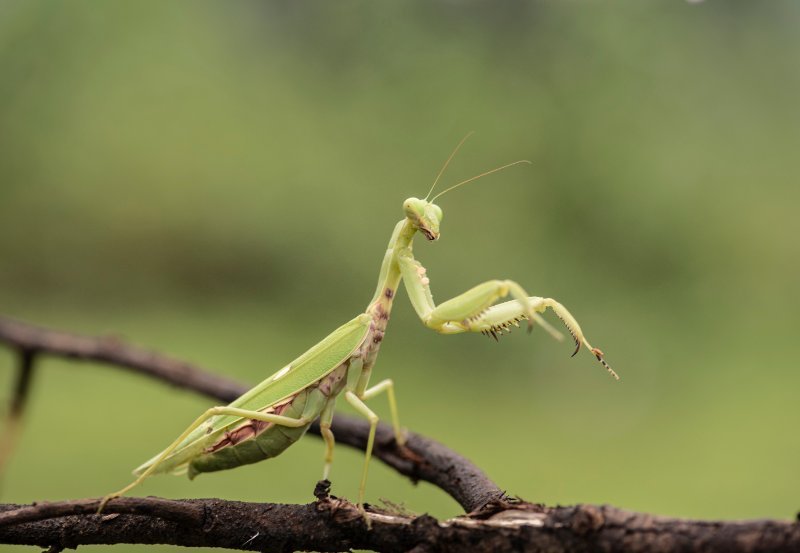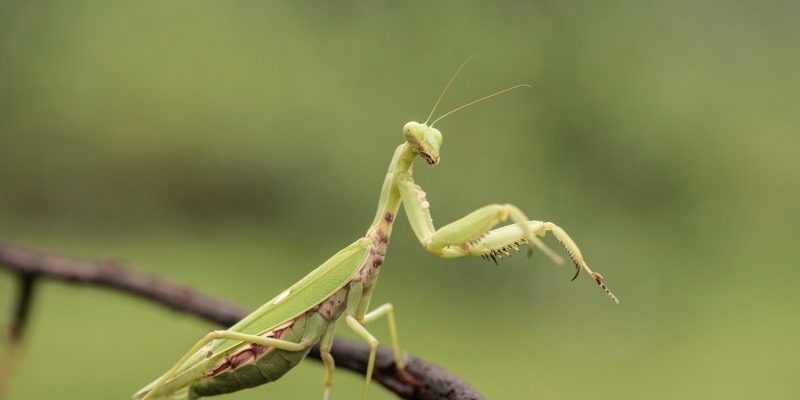
When researchers study the praying mantis, they don’t just look at its looks—they explore its hunting techniques, behavior, reproduction, and even how it contributes to the ecosystem. Think of scientists as detectives, piecing together clues about life in the insect kingdom. So, let’s jump into the world of the praying mantis and uncover how it’s been studied, what scientists have learned, and why these lessons matter.
Understanding the Praying Mantis: Anatomy and Behavior
The first step in studying any creature is understanding its anatomy. The praying mantis has a striking build that’s tailored for hunting. Its elongated body and flexible neck allow it to turn its head almost 180 degrees, giving it a wide field of vision. This makes it a cunning predator, spotting prey from afar. Researchers are particularly interested in how this unique anatomy aids in its predatory tactics.
But there’s more to this little hunter than meets the eye. The mantis has specialized forelegs, often called “raptorial legs,” that are adapted for grasping prey. When it catches a meal—usually unsuspecting insects—it does so with swift precision. Scientists have studied how these hunting methods have evolved, and they’ve found that different mantis species have developed unique strategies. For example, some use camouflage to blend into their surroundings, while others may engage in hunting group behaviors.
Additionally, the mantis isn’t just about brute strength. Some studies indicate that these insects can predict the movements of their prey, showcasing a kind of intelligence that many wouldn’t expect from such a small creature. Honestly, it’s exhilarating to think about how much there is to learn from observing their everyday actions.
Reproductive Behavior: A Dance of Life and Death
Reproduction in the praying mantis often raises eyebrows due to its sometimes bizarre nature. One of the most talked-about behaviors is sexual cannibalism, where the female may eat the male after mating. Yes, you heard that right! This peculiar ritual has piqued the interest of many scientists trying to uncover its reasoning.
Researchers have proposed a few theories regarding this behavior. One idea is that the female gains nutrients from the male, helping her produce more eggs. Another theory suggests that males who offer themselves as meals might actually increase their chances of offspring survival. It’s a bit of a grim trade-off, and studying this phenomenon provides insights into the complexities of animal behavior and strategies for survival.
Furthermore, studies show a fascinating variation in mating behaviors across mantis species. Some species are more likely to exhibit cannibalism than others, suggesting that environmental factors may influence these behaviors. Researchers have set up controlled experiments to better understand these dynamics, watching how various conditions affect the mantis’s reproductive strategies.
The Praying Mantis and Pest Control
You might be wondering what role praying mantises play in pest control, and it turns out, they’re quite significant! As voracious predators, mantises help manage agricultural pests. Farmers have begun recognizing the benefits of having these creatures in their fields, as they feast on insects that threaten crops.
Scientists have studied how mantises contribute to natural pest control by monitoring their dietary habits. In many cases, researchers find that a single mantis can consume hundreds of pests over its lifetime. This makes them not just fascinating creatures to observe, but also key players in sustainable agriculture.
Farmers often look for ways to encourage mantis populations, like planting flowers that attract them. Being natural pest controllers means mantises can decrease the need for chemical pesticides. This isn’t just good for the environment; it’s beneficial for human health too, reducing our exposure to harmful chemicals.
Evolutionary Insights: The Praying Mantis Through Time
Studying the praying mantis doesn’t just tell us about these insects today; it offers a window into their evolutionary history. Scientists have traced mantis fossils back millions of years, revealing how they have adapted to their environments. Analyzing these fossils helps researchers piece together how these insects have survived various ecological changes.
One fascinating detail is that mantises are more closely related to cockroaches and termites than you might expect. This prompts questions about *why* certain traits evolved. What was the advantage of developing those raptorial legs or the ability to camouflage? By comparing current mantis species to their ancient relatives, scientists can hypothesize how specific traits emerged in response to environmental pressures.
Additionally, genetic studies have helped clarify the relationships among different mantis species. Through DNA analysis, scientists can understand how these species diverged and adapted over time. This branch of research not only enhances our knowledge of mantises but adds to our broader understanding of evolutionary biology.
Praying Mantis: A Model Organism in Scientific Research
In recent years, the praying mantis has taken on a role as a *model organism* in various fields of research. This means scientists use it to study complex biological processes. For example, mantises can help researchers better understand predatory behaviors and visual perception.
One fascinating area of study is how mantises perceive motion. Their unique eye structure allows them to detect movement in a way that’s very different from humans. Experiments have shown that mantises can track fast-moving objects, giving insight into how our own visual systems might work. This research extends to robotics, where engineers look to mimic mantis vision to improve machine design.
Moreover, mantises are also being studied in the context of neural circuits. By examining how their brains process information, scientists hope to discover more about the fundamental principles of nervous system organization. The praying mantis isn’t just an insect; it’s a tool for understanding the complex web of life.
The Ecological Importance of the Praying Mantis
Understanding the ecological role of the praying mantis is vital. These insects don’t just exist in isolation; they are part of a larger ecosystem. Their presence in the food web helps maintain balance. By predating on various insects, mantises control populations and indirectly support plant health.
Researchers have observed that in areas where mantises thrive, there’s often a noticeable difference in insect populations and plant growth. This goes to show that every creature, no matter how small, plays a role in the health of their environment.
Furthermore, the praying mantis can serve as a bioindicator. This means that their health and population levels can help scientists gauge the overall health of an ecosystem. If mantis populations decline, it could signal wider ecological issues, prompting further investigation.
The world of the praying mantis is filled with surprises and valuable lessons. From their unique hunting strategies to their complex reproductive behaviors, these insects have a lot to teach us about life. Scientists studying the praying mantis are uncovering insights that resonate beyond entomology, illuminating aspects of ecology, evolution, and even technology.
So, the next time you see a mantis in your garden, take a moment to appreciate its beauty and significance. Who knows? You might just be looking at one of nature’s smallest yet most profound teachers, reminding us of the intricate connections that bind all life together.

